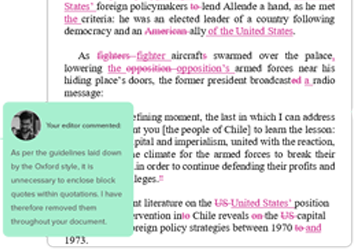- A List of Writing Contests in 2022 | Exciting Prizes!
- Em Dash vs. En Dash vs. Hyphen: When to Use Which
- Book Proofreading 101: The Beginner’s Guide
- Screenplay Editing: Importance, Cost, & Self-Editing Tips
- Screenplay Proofreading: Importance, Process, & Cost
- Script Proofreading: Rates, Process, & Proofreading Tips
- Manuscript Proofreading | Definition, Process & Standard Rates
- Tips to Write Better if English Is Your Second Language
- Novel Proofreading | Definition, Significance & Standard Rates
- Top 10 Must-Try Writing Prompt Generators in 2024
- 100+ Creative Writing Prompts for Masterful Storytelling
- Best 101 Greatest Fictional Characters of All Time
- Top 10 eBook Creator Tools in 2024: Free & Paid
- 50 Timeless and Unforgettable Book Covers of All Time
- What Is Flash Fiction? Definition, Examples & Types
- Best Book Review Sites of 2024: Top 10 Picks
- 80 Enchanting Christmas Writing Prompts for Your Next Story
- Your Guide to the Best eBook Readers in 2024
- Top 10 Book Review Clubs of 2024 to Share Literary Insights
- 2024’s Top 10 Self-Help Books for Better Living
- Writing Contests 2023: Cash Prizes, Free Entries, & More!
- Top 10 Book Marketing Services of 2024: Features and Costs
- Top 10 Book Publishing Companies in 2024
- What Is a Book Teaser and How to Write It: Tips and Examples
- Audiobook vs. EBook vs. Paperback in 2024: (Pros & Cons)
- How to Get a Literary Agent in 2024: The Complete Guide
- Best Fonts and Sizes for Books: A Complete Guide
- Alpha Readers: Where to Find Them and Alpha vs. Beta Readers
- Author Branding 101: How to Build a Powerful Author Brand
- How to Write a Book Report | Steps, Examples & Free Template
- A Guide on How to Write a Book Synopsis: Steps and Examples
- How to Write a Book Review (Meaning, Tips & Examples)
- Book Title Generators: Top 10 Book Name Generators of 2024
- 50 Best Literary Agents in the USA for Authors in 2024
- Building an Author Website: The Ultimate Guide with Examples
- Top 10 Book Printing Services for Authors in 2024
- 10 Best Free Online Grammar Checkers: Features and Ratings
- What Is a Poem? Poetry Definition, Elements, & Examples
- Top 10 Paraphrasing Tools for All (Free & Paid)
- Top 10 Book Editing Software in 2024 (Free & Paid)
- What Is an Adverb? Definition, Types, & Practical Examples
- What Are Large Language Models and How They Work: Explained!
- What Is an Adjective? Definition, Usage & Examples
- Top 10 Hardcover Book Printing Services [Best of 2024]
- 2024’s Top 10 Setting Generators to Create Unique Settings
- Different Types of Characters in Stories That Steal the Show
- Top 10 Screenplay & Scriptwriting Software (Free & Paid)
- 10 Best AI Text Generators of 2024: Pros, Cons, and Prices
- Top 10 Must-Try Character Name Generators in 2024
- How to Track Changes in Google Docs: A 7-Step Guide
- 10 Best AI Text Summarizers in 2024 (Free & Paid)
- 2024’s 10 Best Punctuation Checkers for Error-Free Text
- Top 10 AI Rewriters for Perfect Text in 2024 (Free & Paid)
- 10 Best Plot Generators for Engaging Storytelling in 2024
- 11 Best Story Structures for Writers (+ Examples!)
- How to Write a Book with AI in 2024 (Free & Paid Tools)
- Writing Contests 2024: Cash Prizes & Free Entries!
- Patchwork Plagiarism: Definition, Types, & Examples
- 15 Powerful Writing Techniques for Authors in 2024
- Simple Resume Formats for Maximum Impact With Samples
- What Is a Complement in a Sentence? (Meaning, Types & Examples)
- What are Clauses? Definition, Meaning, Types, and Examples
- Persuasive Writing Guide: Techniques & Examples
- How to Paraphrase a Text (Examples + 10 Strategies!)
- 10 Best Translation Services of 2024 (Features Explained)
- 10 Best AI Writing Assistants of 2024 (Features + Pricing)
- Generative AI: Types, Impact, Advantages, Disadvantages
- Top 10 AI Translators for High-Quality Translation in 2024
- Top 10 AI Tools for Research in 2024 (Fast & Efficient!)
- A Simple Proofreading Checklist to Catch Every Mistake
- Top 10 AI Resume Checkers for Job Seekers (Free & Paid)
- 20 Best Comic Book Covers of All Time!
- How to Edit a Book: A Practical Guide with 7 Easy Steps
- How to Write an Autobiography (7 Amazing Strategies!)
- How to Publish a Comic Book: Nine Steps & Publishing Costs
- Passive and Active Voice (Meaning, Examples & Uses)
- How to Publish a Short Story & Best Publishing Platforms
- Top 10 Book Distribution Services for Authors in 2024
- 50 Best Essay Prompts for College Students in 2024
- What Is Expository Writing? Types, Examples, & 10 Tips
- 10 Best Introduction Generators (Includes Free AI Tools!)
- Creative Writing: A Beginner’s Guide to Get Started
- How to Sell Books Online (Steps, Best Platforms & Tools)
- Top 10 Book Promotion Services for Authors (2025)
- 15 Different Types of Poems: Examples & Insight into Poetic Styles
- 25 Figures of Speech Simplified: Definitions and Examples
- 10 Best Book Writing Apps for Writers 2025: Free & Paid!
- Top 10 AI Humanizers of 2025 [Free & Paid Tools]
- Top 101 Bone-Chilling Horror Writing Prompts
- Writing Contests 2025: Cash Prizes, Free Entries, and More!
- How to Write a Poem: Step-by-Step Guide to Writing Poetry
- 14 Punctuation Marks: Examples & Free Guide on How to Use
- Top 10 Book Writing Software, Websites, and Tools in 2025
- 10 Best AI Detector Tools in 2025
- 100+ Amazing Short Story Ideas to Craft Unforgettable Stories
- The Top 10 Literary Devices: Definitions & Examples
- What is a Book Copyright Page?
- Final Checklist: Is My Article Ready for Submitting to Journals?
- 8 Pre-Publishing Steps to Self-Publish Your Book
- 7 Essential Elements of a Book Cover Design
- How to Copyright Your Book in the US, UK, & India
- How to Format a Book in 2024: 7 Tips for Print & EBooks
- Beta Readers: Why You Should Know About Them in 2024
- How to Publish a Book in 2024: Essential Tips for Beginners
- ISBN Guide 2024: What Is an ISBN and How to Get an ISBN
- Book Cover Design Basics: Tips & Best Book Cover Ideas
- Why and How to Use an Author Pen Name: Guide for Authors
- How to Hire a Book Editor in 5 Practical Steps
- Self-Publishing Options for Writers
- How to Promote Your Book Using a Goodreads Author Page
- 7 Essential Elements of a Book Cover Design
- What Makes Typesetting a Pre-Publishing Essential for Every Author?
- 4 Online Publishing Platforms To Boost Your Readership
- Typesetting: An Introduction
- Quick Guide to Novel Editing (with a Self-Editing Checklist)
- Quick Guide to Book Editing [Complete Process & Standard Rates]
- 10 Best Self-Publishing Companies of 2024: Price & Royalties
- Self-Publishing vs. Traditional Publishing: 2024 Guide
- How to Publish a Book in 2024: Essential Tips for Beginners
- ISBN Guide 2024: What Is an ISBN and How to Get an ISBN
- How to Publish a Book on Amazon: 8 Easy Steps [2024 Update]
- A Beginner’s Guide to Self-Publishing a Book in 2024
- What are Print-on-Demand Books? Cost and Process in 2024
- What Are the Standard Book Sizes for Publishing Your Book?
- Top 10 EBook Conversion Services for 2024’s Authors
- How to Copyright a Book in 2024 (Costs + Free Template)
- How to Market Your Book on Amazon to Maximize Sales in 2024
- Top 10 Hardcover Book Printing Services [Best of 2024]
- How to Find an Editor for Your Book in 8 Steps (+ Costs!)
- What Is Amazon Self-Publishing? Pros, Cons & Key Insights
- Manuscript Editing in 2024: Elevating Your Writing for Success
- Know Everything About How to Make an Audiobook
- A Simple 14-Point Self-Publishing Checklist for Authors
- How to Write an Engaging Author Bio: Tips and Examples
- Book Cover Design Basics: Tips & Best Book Cover Ideas
- How to Publish a Comic Book: Nine Steps & Publishing Costs
- Why and How to Use an Author Pen Name: Guide for Authors
- How to Sell Books Online (Steps, Best Platforms & Tools)
- A Simple Guide to Select the Best Self-Publishing Websites
- 10 Best Book Cover Design Services of 2025: Price & Ratings
- How Much Does It Cost to Self-Publish a Book in 2025?
- How to start your own online publishing company?
- 8 Tips To Write Appealing Query Letters
- Self-Publishing vs. Traditional Publishing: 2024 Guide
- How to Publish a Book in 2024: Essential Tips for Beginners
- ISBN Guide 2024: What Is an ISBN and How to Get an ISBN
- What are Print-on-Demand Books? Cost and Process in 2024
- Top 10 Book Publishing Companies in 2024
- How to Write a Query Letter (Examples + Free Template)
- Third-person Point of View: Definition, Types, Examples
- How to Write an Engaging Author Bio: Tips and Examples
- How to Publish a Comic Book: Nine Steps & Publishing Costs
- How to Create Depth in Characters
- Starting Your Book With a Bang: Ways to Catch Readers’ Attention
- How to Write a Powerful Plot in 12 Steps
- Research for Fiction Writers: A Complete Guide
- Short stories: Do’s and don’ts
- How to Write Dialogue: 7 Rules, 5 Tips & 65 Examples
- What Are Foil and Stock Characters? Easy Examples from Harry Potter
- How To Write Better Letters In Your Novel
- On Being Tense About Tense: What Verb Tense To Write Your Novel In
- How To Create A Stellar Plot Outline
- How to Punctuate Dialogue in Fiction
- On Being Tense about Tense: Present Tense Narratives in Novels
- The Essential Guide to Worldbuilding [from Book Editors]
- What Is Point of View? Definition, Types, & Examples in Writing
- How to Create Powerful Conflict in Your Story | Useful Examples
- How to Write a Book: A Step-by-Step Guide
- How to Write a Short Story in 6 Simple Steps
- How To Craft a Murder Mystery Story
- How to Write a Novel: 8 Steps to Help You Start Writing
- What Is a Stock Character? 150 Examples from 5 Genres
- How to Write a Children’s Book: An Easy Step-by-Step Guide
- Joseph Campbell’s Hero’s Journey: Worksheet & Examples
- Novel Outline: A Proven Blueprint [+ Free Template!]
- Character Development: 7-Step Guide for Writers
- Foil Character: Definition, History, & Examples
- What Is NaNoWriMo? Top 7 Tips to Ace the Writing Marathon
- What Is the Setting of a Story? Meaning + 7 Expert Tips
- Theme of a Story | Meaning, Common Themes & Examples
- 5 Key Elements of a Short Story: Essential Tips for Writers
- What Is a Blurb? Meaning, Examples & 10 Expert Tips
- What Is Show, Don’t Tell? (Meaning, Examples & 6 Tips)
- How to Write a Book Summary: Example, Tips, & Bonus Section
- How to Write a Book Description (Examples + Free Template)
- 10 Best Free AI Resume Builders to Create the Perfect CV
- A Complete Guide on How to Use ChatGPT to Write a Resume
- 10 Best AI Writer Tools Every Writer Should Know About
- What Is an Adverb? Definition, Types, & Practical Examples
- How to Write a Book Title (15 Expert Tips + Examples)
- What Is an Adjective? Definition, Usage & Examples
- 10 Best AI Story Generators in 2024
- 100 Novel and Book Ideas to Start Your Book Writing Journey
- Exploring Writing Styles: Meaning, Types, and Examples
- Mastering Professional Email Writing: Steps, Tips & Examples
- How to Write a Screenplay: Expert Tips, Steps, and Examples
- Business Proposal Guide: How to Write, Examples and Template
- Different Types of Resumes: Explained with Tips and Examples
- How to Create a Memorable Protagonist (7 Expert Tips)
- How to Write an Antagonist (Examples & 7 Expert Tips)
- Writing for the Web: 7 Expert Tips for Web Content Writing
- 10 Best AI Text Generators of 2024: Pros, Cons, and Prices
- What are the Parts of a Sentence? An Easy-to-Learn Guide
- How to Avoid AI Detection in 2024 (6 Proven Techniques!)
- How to Avoid Plagiarism in 2024 (10 Effective Strategies!)
- 10 Best Spell Checkers of 2024: Features, Accuracy & Ranking
- What Is Climax Of A Story & How To Craft A Gripping Climax
- What Is a Subject of a Sentence? Meaning, Examples & Types
- Object of a Sentence: Your Comprehensive Guide
- What Is First-Person Point of View? Tips & Practical Examples
- Second-person Point of View: What Is It and Examples
- 10 Best AI Essay Outline Generators of 2024
- Third-person Point of View: Definition, Types, Examples
- The Importance of Proofreading: A Comprehensive Overview
- Patchwork Plagiarism: Definition, Types, & Examples
- Simple Resume Formats for Maximum Impact With Samples
- The Ultimate Guide to Phrases In English – Types & Examples
- Modifiers: Definition, Meaning, Types, and Examples
- What are Clauses? Definition, Meaning, Types, and Examples
- Persuasive Writing Guide: Techniques & Examples
- What Is a Simile? Meaning, Examples & How to Use Similes
- Mastering Metaphors: Definition, Types, and Examples
- 10 Best AI Writing Assistants of 2024 (Features + Pricing)
- Generative AI: Types, Impact, Advantages, Disadvantages
- How to Publish a Comic Book: Nine Steps & Publishing Costs
- Essential Grammar Rules: Master Basic & Advanced Writing Skills
- Benefits of Using an AI Writing Generator for Editing
- Hyperbole in Writing: Definition and Examples
- 15 Best ATS-Friendly ChatGPT Prompts for Resumes in 2025
- How to Write a Novel in Past Tense? 3 Steps & Examples
Still have questions? Leave a comment

Checklist: Dissertation Proposal
Enter your email id to get the downloadable right in your inbox!

Examples: Edited Papers
Enter your email id to get the downloadable right in your inbox!
Need
Editing and
Proofreading Services?

How to Write a Children’s Book: An Easy Step-by-Step Guide
 Sep 05, 2023
Sep 05, 2023 5
min read
5
min read
Writing a children’s book comprises a lot more than just elaborating on a story idea and adding attractive images. It involves developing an age-appropriate story that fascinates kids and enthralls them till the end. So how to write a children’s book that captures the short attention span of your young readers?
Well, there are ten steps to writing a children’s book:
- Target the right age group
- Find an idea that’ll work
- Develop your idea into a story
- Create kid-friendly characters
- Keep the story fast-paced and exciting
- Create catchphrases
- Think graphically
- Add an attractive title
- Revise the draft
- Look for editors and illustrators
Let’s take a closer look at these tips for writing children’s books.
1. Target the right age group
You may be surprised to know that the children’s book category includes books for all ages from 0 to 18! This includes diverse sub-genres from board books for newborn babies to fiction and non-fiction for young adults (Y/A). So before you begin writing books for kids, you need to determine your target audience’s age category.
Understanding your target audience is also essential to marketing your book effectively. The first thing that publishers, educators, and parents will check is the age group your book caters to. You’ll have to be quite specific about your readers if you want your book to do well in the market.
Here are the different age categories and the types of children’s books for them:
- 0- to 4-year-olds: Board books
- 2- to 5-year-olds: Early picture books
- 4- to 8-year-olds: Activity books, novelty books
- 5- to 8-year-olds: Early reader fiction
- 6- to 9-year-olds: Chapter books
- 8- to 12-year-olds: Middle grade books
- 12- to 18-year-olds: Young adult books
Note that the age categories for children’s books may vary slightly based on your source. There are always some overlaps in these categories, so you’ll have to undertake some hefty research!
2. Find an idea that will work
It’s important to know your readers before you explore ideas for your children’s book-writing endeavor. At the same time, you must also figure out what their parents seek.
Wondering where to look for ideas and how to start a children’s book? You can begin by interacting with kids of the age group you’re writing for. Consider visiting popular bookstores to notice the themes that attract kids belonging to your target age group. This will help determine what may work and what may not when you’re writing a kid’s book.
To determine whether an idea can work, try answering the following questions:
- What’s the basic theme of my story?
- Why do I want to tell this story?
- Is this idea unique?
- Are my theme and idea relatable to kids?
3. Develop your idea into a story
When exploring how to write a children’s book, the next step would be developing your idea into a compelling story. Make sure to do your research for fiction writing before embarking on this journey.
The idea is to begin your story with a hook, which is one of the effective ways to catch readers’ attention. It will infuse excitement and drama in your writing to engage your young readers.
As you go about writing the story, stop for short intervals. Read out what you have written and listen carefully. Ask yourself if the storyline is gripping enough to hold your interest and that of your young audience.
Furthermore, remember the importance of crafting a satisfying conclusion that ties up all the loose ends when writing children’s books. A well-written conclusion will leave a lasting impression on young readers and leave them eager for more adventures.
4. Create kid-friendly characters
When seeking tips for writing children’s books, one essential aspect to consider is the stock characters available to you. Develop these archetypes into lovable, memorable, and relatable characters.
As the story progresses, let your protagonist develop wisdom, skills, and strength. Introduce obstacles in your story and allow your protagonist to overcome them and learn from these experiences. Such a character arc fascinates kids and enables them to learn valuable life lessons.
Take a few examples of children’s books that have iconic characters. You can opt for books like Pippi Longstocking or Matilda by Roald Dahl. Analyze them to understand how to create relatable characters with depth and then proceed to create your own characters.
5. Keep the story fast-paced and exciting
When delving into how to write a children’s book, maintaining a quick-paced and thrilling narrative is crucial. You have to ensure that the story progresses at a fast pace as well. This helps to keep the excitement level high among young readers.
One trick to apply here is to use short and crisp sentences for your narrative. By using shorter sentences, you can infuse a vibe of urgency into the story. There’s another advantage to this: Children need less time to read shorter sentences. This helps to grasp their concentration and retain it on the page.
You can also introduce dramatic subplots when you write a children’s book. This is another effective idea to make your story an exciting read. But make sure to stay away from unnecessary descriptions for maximum effect.
6. Create catchphrases
Have you ever wondered why writers create catchphrases for their characters? The simple answer is to lend a unique voice to a character and ensure that it stands out.
By using captivating catchphrases, you can bring alive your characters. Catchphrases and memorable lines are your key to creating a lasting impression on the minds of your young readers.
But when it’s a question of how to write a kid’s book with catchphrases, you need to remember two points.
- Always limit your catchphrases to just a few characters and select those characters wisely.
- Make sure that you don’t use the catchphrase of a character too much or too often.
7. Think graphically
As an author, you need to think about how to make a children’s book come alive visually. This is where graphic elements can help you. These elements and captivating imagery can elevate your narrative and take it to the next level.
But make sure to write your first draft without using images. This is important since it will allow you to bring alive your imaginary world with the help of words. Once this is done, you can add images to complement your story.
Remember that you should depend on the imagery to create a visual roadmap for your narrative. You should not use it to do all your storytelling work.
8. Add an attractive title
The title of your children’s book carries a lot of importance. It creates the first impression of the book and sets the tone for the story.
To come up with an impressive title when writing books for kids, identify the most important theme or moment in your story. You can then convert it into a catchy title. Another idea that almost always works is to use the name of the main character as the title.
Just remember that the title you pick should resonate with your young audience. It should invite them into a world of wonder and imagination.
9. Revise the draft
Once you’re done writing the first draft, it’s time to turn it into a more polished version. For that, you need to reread and revise it. Sometimes you may need a couple of revisions before being satisfied.
As you go about revising your draft, pay attention to the following points:
- Do the story and the characters appeal to you?
- Are there plot holes in the story?
- Is there a need to rewrite any part of the content?
Be open to seeking feedback from others, such as fellow writers, teachers, or editors. Their perspectives can help you refine and elevate your draft further.
10. Look for editors and illustrators
You need a talented illustrator who can enrich your story through their artistic talent. If you’re self-publishing your book, it’s your job to hire an illustrator who can elevate your story visually. Go through online reviews and recommendations while you’re selecting an illustrator and make sure to clearly communicate your ideas to them.
The work of a book editor involves reviewing your manuscript thoroughly to mark out errors. These can be errors in your language or formatting errors. They also suggest how to improve your story further.
Unless you’re extremely talented and with lots of time to spare, you’ll certainly require professional help while editing and illustrating a children’s book. So, opt for an editing or self-publishing service that has expertise in publishing kids’ stories.
So those were the ten steps to writing a children’s book. You’ll have to invest a lot of your imagination and creativity, streamlining your book-writing efforts, so you can create a fantastic story. So, go ahead, allow your imagination to flow freely and enjoy your kids’ book writing journey!
As your favorite literary editors, we have some more resources that will help you out. Take a look:
- How to Write a Powerful Plot in 12 Steps
- How to Write Dialogue: 7 Rules, 5 Tips & 65 Examples
- What Is Point of View: 1st, 2nd & 3rd POV with Examples
- How to Write a Book: A Step-by-Step Guide
- What is NaNoWriMo? Top 7 Tips to Ace the Writing Marathon
- Book Title Generators: Top 10 Book Name Generators of 2024






